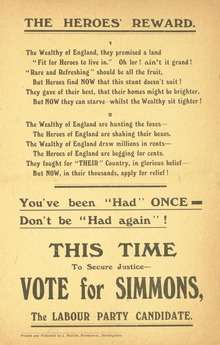Charles Simmons (politician)

Charles James "Jim" Simmons (9 April 1893 – 11 August 1975) was a British lecturer, journalist and politician.[1]
Simmons was born in Moseley, Birmingham. Following elementary education, he became a Primitive Methodist lay preacher at the age of 16. In World War I he served in the Worcestershire Regiment, seeing action in France, Egypt and Gallipoli. He was twice imprisoned whilst in the army, for appearing in uniform at a peace rally and for protesting against field punishments. He lost his leg at the Battle of Vimy Ridge.[1]
Following the war, he was a leading member of NUX the National Union of Ex-Servicemen, which fought for the rights of those returning from the war. His more militant stance, but reformist not revolutionary, was weakened as many of his comrades left to join the newly formed Communist Party. The NUX was later to effectively disappear as it played an important role in the foundation of the British Legion. Simmons remained active for ex-Servicemen in local organisations. Jim Simmons also played a leading role in the Labour Churches movement.He gained political office as a member of Birmingham City Council from 1921–1931 and 1942–1945.[1]
Member of parliament for Erdington
Simmons was selected as the Labour Party's candidate to contest Birmingham Erdington at the 1924 general election.[2] He failed to unseat the sitting Conservative MP, Sir Arthur Steel-Maitland in a straight fight.[3]
At the next general election in 1929, he was again Labour candidate at Erdington. As well as Steel-Maitland, a Liberal, H J H Dyer, was also nominated to contest the seat.[4] Simmons defeated Steel-Maitland by the narrow margin of 133 votes, benefitting from the fact that Dyer received more than 6,300 votes.[5] The election had been very bitter, with Simmons issuing a leaflet accusing Steel-Maitland of abusing his position as Minister for Labour and using a charitable fund to subsidise colliery owners to employ miners at less than the minimum wage. Following a threat by the defeated MP to begin libel proceedings, Simmons issued a formal apology.[6]
Two years later another general election was called. Simmons defended his seat against a new Conservative opponent J F Eales.[7] There was a large swing against Labour, and Eales defeated Simmons by the majority of nearly 19,000 votes.[8]
At the next general election in 1935 Simmons attempted to regain the Erdington seat from Eales. This time it was a three-cornered contest, with an independent candidate also standing.[9] He failed to be elected, increasingly his vote only marginally.[10]
On the death of Eales, Simmons also unsuccessfully contested the 1936 by-election, which was to be the last contest until 1945, owing to the Second World War. Simmons found work as a political journalist, editing the Town Crier, the journal of the Birmingham Trades Council from 1940–1945.[1]
Member of parliament for Birmingham West
Simmons was nominated as Labour candidate for Birmingham West at the 1945 general election, in opposition to the sitting Conservative MP Walter Higgs.[11] There was a landslide to Labour, and he won the seat comfortably.[12] He was a member of the Labour Government 1945-1951 as a Lord of the Treasury from 30 March 1946 to 1 February 1949, after which he served as Parliamentary Secretary to the Minister for Pensions.[13]
Member of parliament for Brierley Hill
Following boundary changes, Simmons became MP for the new Black Country constituency of Brierley Hill from the 1950 general election.[14][15] He held the seat at the 1955 election, but was unexpectedly defeated by his Conservative opponent at the 1959 general election.[16] Simmons was a strong advocate of the Temperance movement, and campaigned for fourteen-year-old children to be banned from the bars of clubs. His defeat in 1959 was believed to have been partly attributable to the opposition of brewery interests.[1]
He wrote his autobiography Soapbox Evangelist in 1971. He died in 1975, survived by his four sons and second wife.[1]
References
George Barnsby; Socialism in Birmingham and the Black Country 1850-1939 (1998)
- 1 2 3 4 5 6 "Mr C. J. Simmons". The Times. 19 August 1975. p. 19.
- ↑ "The General Election. First List Of Candidates, Choice Of The Parties". 15 October 1924. p. 7.
- ↑ "The General Election. First Returns, Polling In The Boroughs.". The Times. 30 October 1924. p. 6.
- ↑ "Declarations To-Night. 200 Results Expected.". 30 May 1929. p. 10.
- ↑ "The General Election. First Returns, Polling In The Boroughs.". The Times. 31 May 1929. p. 6.
- ↑ "Political Notes Labour M.P.'S Apology To Ex-Minister". The Times. 25 October 1929. p. 16.
- ↑ "The General Election: "The Times" List Of Candidates". The Times. 10 October 1931. p. 6.
- ↑ "The General Election First Returns, Polling In The Boroughs". The Times. 28 October 1931. p. 6.
- ↑ "The General Election: List Of Nominations". The Times. 5 November 1935. p. 8.
- ↑ "The General Election First Returns, Polling In The Boroughs". The Times. 15 November 1935. p. 8.
- ↑ "The General Election: List Of Nominations". The Times. 26 June 1945. p. 6.
- ↑ "General Election Results 1945". The Times. 27 July 1945. p. 9.
- ↑ "New Junior Ministers". The Times. 2 February 1949. p. 4.
- ↑ "The General Election: "The Times" List Of Candidates". The Times. 11 January 1950. p. 3.
- ↑ "General Election Results". The Times. 25 February 1950. p. 19.
- ↑ "Continuing Red With A Few Blue Spots. Staffordshire Set Fair For Labour". The Times. 24 September 1959. p. 16.
External links
Hansard 1803–2005: contributions in Parliament by C J Simmons
| Parliament of the United Kingdom | ||
|---|---|---|
| Preceded by Arthur Steel-Maitland |
Member of Parliament for Birmingham Erdington 1929–1931 |
Succeeded by John Frederick Eales |
| Preceded by Walter Higgs |
Member of Parliament for Birmingham West 1945–1950 |
Constituency abolished |
| New constituency | Member of Parliament for Brierley Hill 1950–1959 |
Succeeded by John Ellis Talbot |